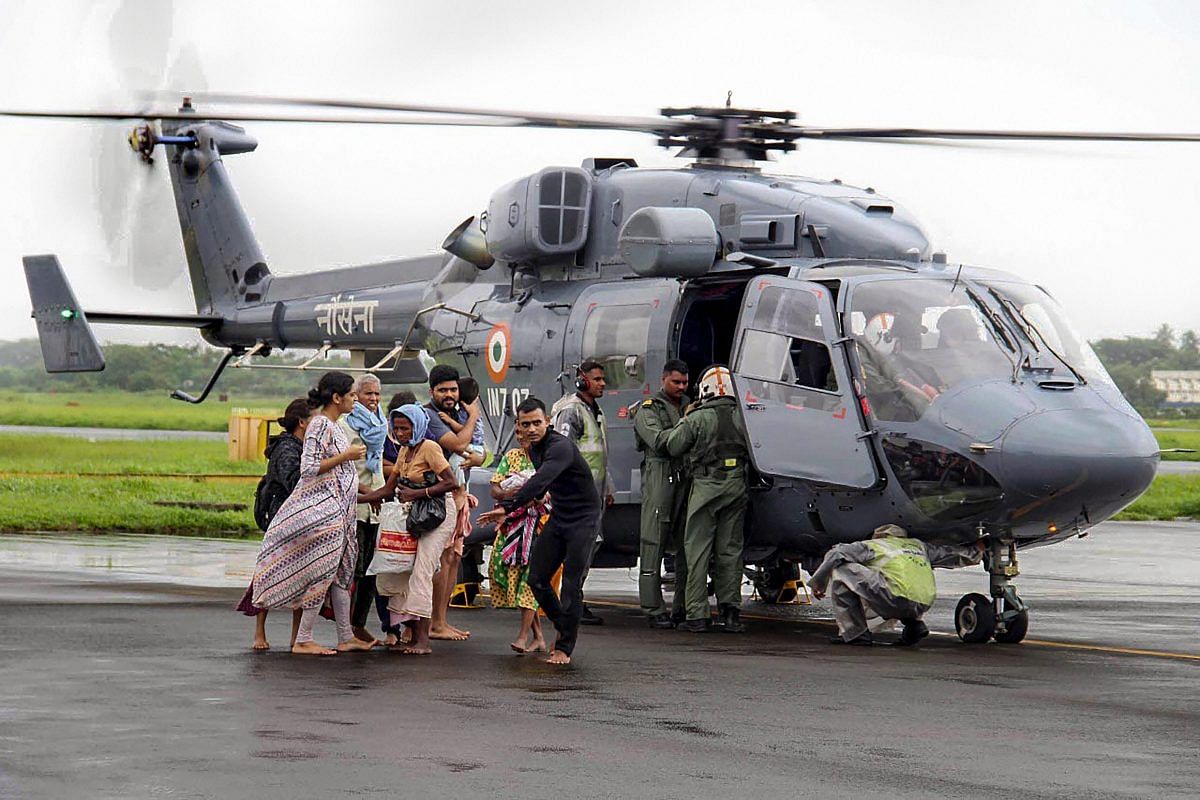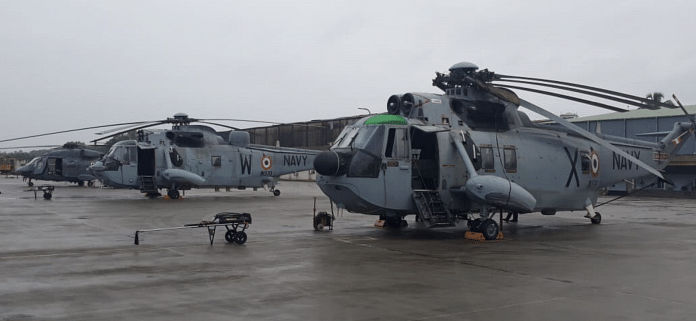At least two efforts by the Indian Navy to modernise its helicopter fleet are stuck in red tape, with many of its choppers first inducted in 1987.
New Delhi: On a stormy night last December, Captain P. Rajkumar of the Indian Navy was hovering above the sea swells off the Kerala coast. Cyclone Ockhi had devastated the region, and the captain and his crew were rescuing a fisherman clinging onto his capsized boat.
This Sunday, Capt. Rajkumar took his Sea King 42B, negotiated it between coconut trees, and hovered his helicopter above a narrow rooftop, rescuing 26 people stranded in the Kerala floods.
In disaster after disaster, men and women of the armed forces fly aged or ageing helicopters to conduct the most daring of rescues. Yet, slothful administrative processes have denied the forces the most basic and essential of modern aircraft that have proved their versatility in both civil and military emergencies.
At least two efforts by the Indian Navy to modernise its helicopter fleet are stuck in red tape, with slothful administrative processes denying the forces. As a result, in over 30 years, the Indian Navy is yet to add to its fleet helicopters that would be capable of replacing the Sea King, its most versatile and efficient helicopter.
Largest fleet, old stock
The Indian armed forces and the Coast Guard still hold some of the largest inventories of helicopters in the world — larger than many air forces. Yet, such is the vastness of the country and the sheer numbers of people impacted season after season that each natural disaster underscores the urgent need for helicopters.
The Sea King 42B that Capt. Rajkumar, a Shaurya Chakra awardee, was flying had been inducted into the navy, along with the INS Viraat, India’s second aircraft carrier, in 1987. The Viraat was commissioned into the Indian Navy after serving British forces for decades.
Also read: Kerala has raised the bar, shamed the Indian conscience on disaster relief
In the years since, the Indian Navy has added just the home-made Dhruv Advanced Light Helicopter, which flies on French engines, but the Dhruv is not in the same class as that of the Sea King.
Old wings
Known as the “flying frigate”, the Sea King is a product of the erstwhile Westland Helicopters, subsequently Agusta Westland, part of the Finmeccanica (now Leonardo) group. The Indian Navy now has nearly 150 ships, each of them capable of carrying at least one, if not two, helicopters.
Aluva Rescue effort pic.twitter.com/b3ZbwZ6vcr
— SpokespersonNavy (@indiannavy) August 16, 2018
The ships mostly sail with their hangars empty or with helicopters that do not meet today’s requirements for surveillance, search and rescue and anti-submarine warfare.
To modernise its fleet, the navy believes it requires 123 Naval Multi-Role Helicopters (NMRH). The procurement process for the NMRH’s was begun in 2000, as the navy looked to replace its Kamov-28 and its Sea Kings. In the intervening years, the number of Sea Kings with the navy has reduced to just about double digits.
If the Sea Kings are still flying today and are the mainstay of the navy’s rotary wing requirement, it is because of a combination of reasons, chief among them being that components have been cannibalised from decommissioned aircraft and because the technicians are still able to keep them going.
In desperation, with the procurement of the NMRH practically in cold storage for more than a decade-and-a-half, the navy initiated, during the UPA II government, the acquisition process for 24 MH 60 ‘Romeo’ helicopters from Sikorsky (now part of the Lockheed Martin group). Even that got stuck during contract negotiations.
Also read: Kerala floods: The science behind what went wrong, and what we have to learn
Defence ministry sources told ThePrint that negotiations to acquire the choppers could be revived through the 2 + 2 dialogue early next month. The 2 + 2 dialogue, the first of its kind, will involve the defence and foreign ministers of India and the US.
“There are, of course, a large number of sorties that we cannot fly because of the shortage of helos (helicopters). But there is always a continuous demand from civil authorities,” said one defence ministry official.
Air force better off for civil emergencies
On Friday, defence minister N. Sitharaman told Kerala Chief Minister Pinarayi Vijayan that she had asked the Indian Air Force to deploy more helicopters. The navy is currently sending to Kerala an additional 14 helicopters and the air force may be deploying as many as 54.
The Indian Air Force, with a total inventory of nearly 400 helicopters, is better placed than the navy to deploy for civil emergencies. For Kerala, it has its Air Force Station at Sulur, near Coimbatore, that has one of its largest bases for helicopters, including its showpiece Sarang team.

“It takes between 30 minutes to an hour to turnaround a helicopter, depending on the type and where we are deployed,” says Group Captain Sundeep Mehta (retired) who has commanded helicopter squadrons from the Siachen to natural disaster zones.
“We understand that there is a ‘golden period’ in natural disasters – the first two or three days – when it is most important to save lives,” he says of his experience.
The air force is still looking for 197 Light Utility Helicopters to replace its fleet of Chetaks and Cheetahs that are of the 1960s and 1970s vintage.




Same old story whether Air Force’s MMRCA project to get new fighter aircraft to replace obsolete Migs or Navy’s attempt to find venerable Seaking helicopter replacement for the last 15 years, the politico- beauraucratic establishment just does not accept the militaries urgency to maintain the combat edge. The political class is too timid to sign any major defence contract and bureaucrats in Defence Ministry are too happy to keep delaying taking any decision for which they could be answerable years later. Thus we are reaching that same state as pre- Mughal Hindu kings who had huge armies but no modern warfare weapons such as canons which Babur had and thus with a much smaller army, he defeated these elephant and chariot laden armies of India.
By now, India should have been manufacturing, under licence from the foreign firm, a workhorse helicopter like the Sea King, or a better replacement, steadily increasing its local content. The magnificent men who fly these machines, saving precious lives, may be putting their own at risk. 2. It takes the political executive, once it is voted to power, a little time to master the intricacies of defence procurement. However, the civil servants in the ministries of Defence and Finance, and the senior military leadership representing all three services, in consultation with the CAG, should be in a position to work out a durable defence acquisition system that cuts the time for a procurement of this nature from decades to, say three years. 3. Everyone expects the process of defence acquisition to be transparent, completely above board, because both national security and public funds are involved. However, if some practices are embedded into the system, not just as it pertains to India, the political class can show the maturity to acknowledge that there will be a periodic exchange of power, allow the processes to go forward gracefully.